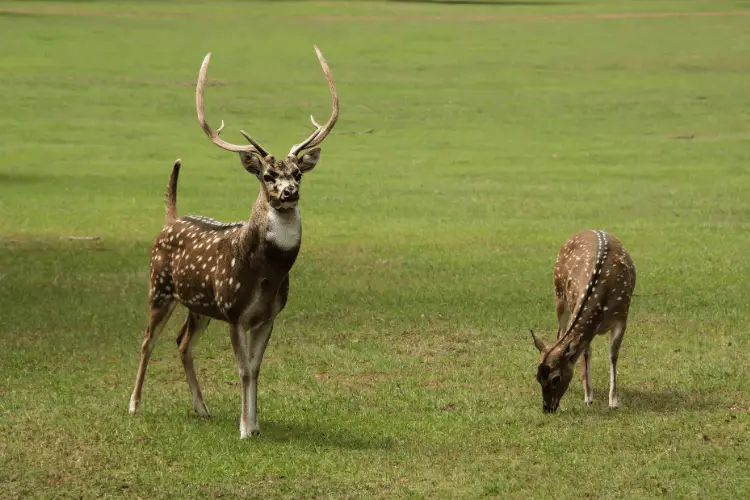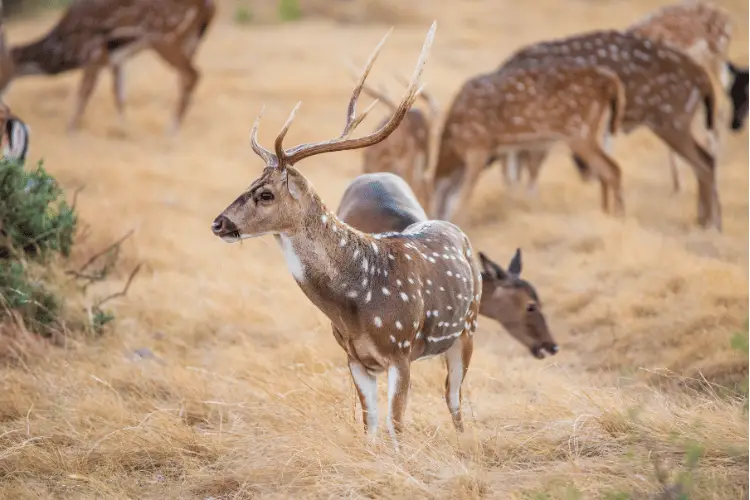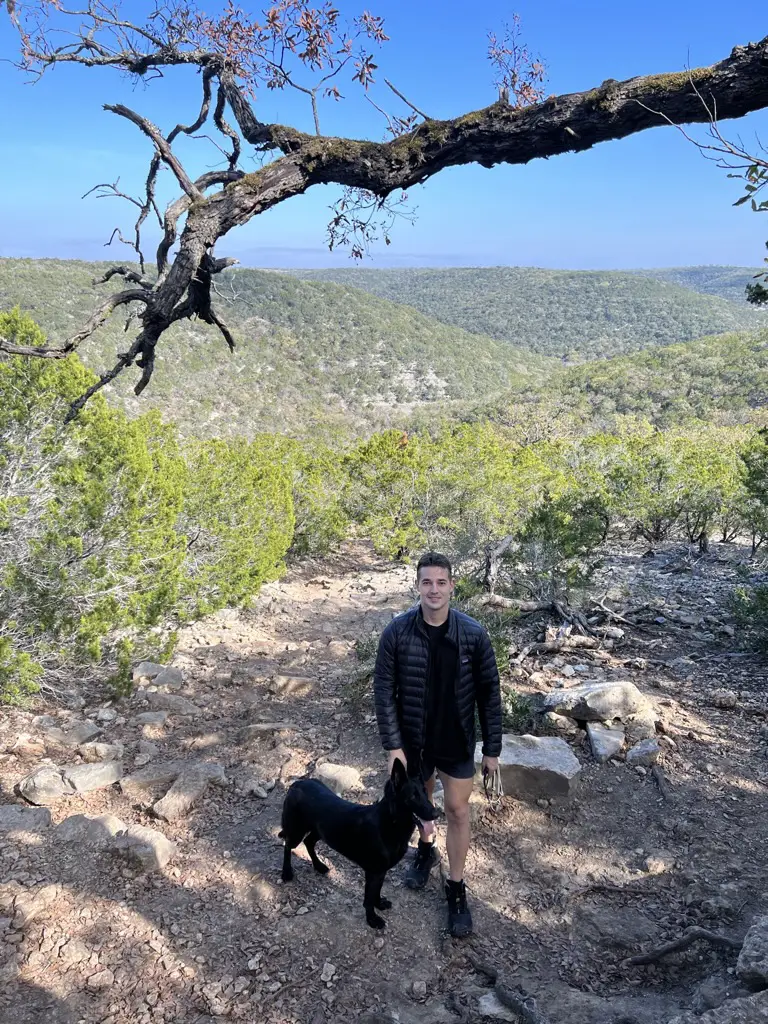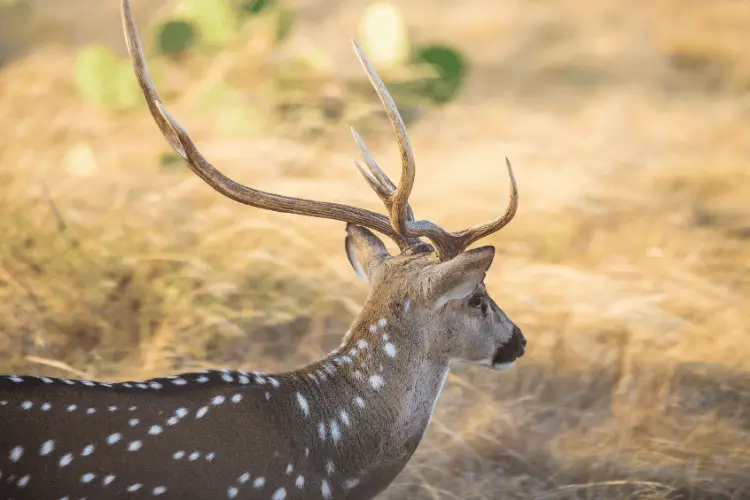We strive to provide you with authoritative, trustworthy, and expert advice. In doing so, the staff at texaswalkabout.com performs extensive research, editing, and fact checking to every post on this webiste. If you feel that this article can improve, please feel free to reach us at staff@texaswalkabout.com
Texas is the largest state in the contiguous US and the second-largest state across the nation after Alaska. With 268,569 square miles of land, Texas’ natural landscape is as vast and diverse as its culture and history.
Between amphibians, birds, mammals, fish, reptiles, invertebrates, and plants, the wildlife in Texas is incredibly rich. It has bears, bats, alligators, snakes, and everything in between, including Axis deer.
Today’s guide dives into everything you need to know about the Texas Axis deer. We’ll cover their origin, history, abundance, habits, hunting, and much more!
What Are Axis Deer?
Axis deer is a species of deer that’s easily recognizable thanks to its orange-toned coat covered in white or pale spots, giving it a cheetah-like appearance.
Both adult males and females sport a white patch on the throat, with antlers growing only on mature males. Females typically weigh between 90 to 150 pounds whereas the average weight of a male ranges from 150 to 250 pounds.
Also known as the cheetal, chital, chital deer, and spotted deer, the axis deer is part of the Axis genus of the Cervidae family. Originally, Axis deer hail from India, Sri Lanka, and Nepal.
The average Axis deer can live from 9 up to 13 years or even longer. In captivity, many cases remain alive for up to 20 years.
Where Do Axis Deer Occur in the US?
Axis deer prefer warm climates, so they’re mainly present in Texas where the heat allows them to thrive.
Mainly active at dawn or dusk, this ungulate species feeds on sedges and grass in fields close to sheltered or wooded areas
Do Axis Deer Pose an Ecological Threat?
The vast similarities in behavior between Axis deer and US native Whitetail deer mean that both species live in the same ecological zone.
As a result, the two deer compete over available resources. However, because Axis deer have a higher resistance against native diseases, their popularity is less prone to decline from local outbreaks of disease compared to Whitetail deer.
This leads to a decrease in Whitetail deer numbers while the population of Axis deer increases quickly and uncontrollably

The growing numbers of Axis deer force them to forage beyond their natural habitat, so they raid the lands of local farmers looking for food and damaging cultivated gardens or fields in the process.
History of Texas Axis Deer
The existence of Axis deer in the US resulted from their introduction into Texas in 1932, which remains the mammal’s primary residence.
Although Axis deer were meant to live in captivity in farms or hunting sites so their numbers could be better controlled for food and game purposes, they managed to escape captivity and establish a home throughout the natural grounds of the Lone Star State.
The number of axis deer in private hunting ranges is estimated at 40,000. On the other hand, the number of free-ranging axis deer is said to be around 6,000 with sources estimating their population in the wild to be at least double that number.
In any case, Axis deer are Texas’ most abundant species of exotic ungulate.
Where Are Axis Deer Located in Texas?
Axis deer were recorded to have established self-sustaining communities as early as 1988. Back then, they were spread over 27 counties across South and Central Texas.
Since then and going into 2021, Axis deer have covered far more ground, expanding into more than 90 counties with a population estimate of over 125,000 deer.
According to Micheal Marrow (Masters in Rangeland Ecology and Wildlife Management from Texas A&M University), counties with the highest numbers of Axis deer are Kerr’s Edwards Plateau, Real, Edwards, and Gillespie.
However, no specific data is available on the population of Axis deer in these counties.
In fact, the documentation of Axis deer numbers in Texas is shockingly inadequate with no accurate population estimates recently and no reliable information on how the spread occurred over time.
Texas Axis Deer Hunts
To aid in the management of the Axis deer overgrown population in Texas, state authorities legalized hunting the animals in the wild after purchasing permits and on private ranges after paying set fees.
Permits are required for hunting free-ranging Axis deer to enable wildlife organizations and local parks to better track the species’ population.
Axis deer hunts in Texas have been going on for more than 90 years with the animal’s meat considered top-quality game meat, its antlers reaching over 3 feet long, and its hide offering style value. Not to mention, it’s quite easy to find.
What Is the Texas Axis Deer Season?
Because Axis deer aren’t native to Texas, they don’t have a particular season. Hunting Axis deer in Texas is possible at any time of the year.
As for their breeding season, Axis deer reproduce throughout the year, although most of it happens during May, June, and July (early and mid-summer). Consequently, the following spring sees a spike in the number of fawns after a gestation period of 7.5 months.

Axis deer reproduce so consistently that if you hunt a doe, it’s almost always guaranteed to be either pregnant or nursing.
Cost of Texas Axis Deer Hunts
The cost of hunting Axis deer in Texas varies depending on whether you’re hunting free range or on a private range.
If you’re going free range, you’ll need a license and permit to legally hunt Axis deer in Texas.
A hunting license for residents is about $25, while a hunting license for non-residents ranges between $48, $132, and $315 according to its type. As for permits, they’re typically free of charge.
If you’re opting for a private ranch to hunt Axis deer, prices differ based on several criteria, including:
- How “exclusive” the range is
- The package you choose
- The accommodation the ranch offers
- The type and size of deer you’re after
You can find options costing $4,500 or $5,500 for a 3-day hunt. Other ranches have a fixed rate per person per day that includes lodging, transportation, meals, guide, and game care, with a fee that you pay after harvesting a trophy depending on the location of the hunt.
Tips for Hunt Texas Axis Deer
To make sure your Axis deer hunt is successful, keep the following tips in mind:
- Educate yourself on the behavior and habits of Axis deer. For example, Axis deer are most active at dusk/dawn and they prefer flatter grounds such as lowlands.
- Hunt using bedding cover since Axis deer often alternate between feeding and bedding during the day. Don’t forget to keep your face in the wind and push through the cover slowly.
- Use the right kind of grub, particularly forbs, grasses, and browse.
- If you opt for the spot and stalk technique, pick a location near the feeding areas.
- While Axis deer can rut year-round, most of the action takes place from May to June. Planning your hunt around this period can increase your harvest chances.
- Axis deer spend a lot of time around water, so be sure to check out similar spots on your trip.
- Try learning the vocalizations of Axis deer to lure them in. You can also listen for their sounds during the rut to help narrow down their whereabouts.
How to Keep Axis Deer Out of Your Farm or Garden
As we mentioned earlier, Axis deer in the wild can raid the lands of local farmers looking for food. They typically end up damaging cultivated gardens or fields in the process.
If you’re looking for ways to save your property from wandering Texas Axis deer, here are a few methods you can try:
- Plant pungent plants to create a natural barrier. Chives, garlic, mint, and lavender can all be effective options.
- Plant deer-resistant plants such as barrenwort, angel’s trumpet, bluebell, daffodil, and forget-me-not.
- Plant prickly plants to naturally deter deer from your crops. Examples include cleome, barberries, and lamb’s ear.
- Build higher fences and incorporate large plant walls using short needle spruces or boxwood hedges to prevent deer from seeing what you’re growing.
- Consider adding unfamiliar objects with movable parts to act as scarecrows. Pair them with bright light or wind chimes for extra effectiveness.
- Keep your garden tidy by getting rid of crops soon after harvest, trimming tall plants, and picking ripe fruits right away.
- Use commercial Axis deer repellents that target the animal’s strong sense of smell.
- Use homemade repellents such as hot pepper sprays, bars of soap, fabric softener strips, and ammonia-soaked rags.
- A pet dog is a natural deer repellent thanks to its barking and scent.
Wrapping Up
There you have, a comprehensive guide to all things Texas Axis deer.
This exotic ungulate species is the most abundant in Texas with experts estimating their population in Texas to be at least 125,000 animals.
With their numbers growing out of control by the year, Axis deer are an ecological threat not only to Whitetail deer but also to farmers and gardeners. The Lone Star State legalized hunting Axis deer with a license and permit to help manage their numbers.

Robert is a native Texan writer for TexasWalkabout, passionate about Texas culture and food, wearing cowboy boots daily. He interviews local pitmasters and chefs, tastes and reviews innovative dishes, and explores hidden gems and iconic landmarks. Graduating magna cum laude in Cyber Security from the University of Texas at San Antonio, Robert excels academically and professionally while also being knowledgeable in Texas history and culture. After living in Texas for over 28 years, he provides first-hand and trustworthy information for all your Texas needs!

